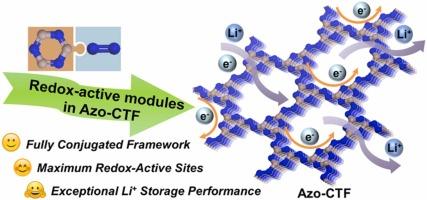具有最大双氧化还原活性位点的全扩展偶氮桥联共价三嗪结构的先进有机锂电池
IF 17.1
1区 材料科学
Q1 CHEMISTRY, PHYSICAL
引用次数: 0
摘要
基于有机电极材料(OEMs)的有机锂电池开辟了开发高性能环保储能器件的新途径。然而,到目前为止,原始设备制造商仍然受到导电性差和容量不理想的严重限制。在此,我们创造性地提出在oem中直接将活性基序与功能连接体结合,以同时提高电导率和容量。作为第一次尝试,我们巧妙地设计和构建了三嗪基与偶氮基直接相连的共价三嗪框架(azo- ctf)。由于偶氮桥和三嗪π单元之间的电子完全共轭,偶氮ctf具有最低能带隙(2.62 eV),具有优异的基本电荷导电性。更令人兴奋的是,偶氮ctf实现了迄今为止最大的氧化还原活性位点整合(质量比达到70%)。因此,Azo-CTF阳极表现出几乎创纪录的性能,具有高可逆容量(2332.8 mAh g-1, 0.1 a g-1)和激励的速率特性(1034.4 mAh g-1,在2 a g-1下进行500次循环,690.2 mAh g-1,在5 a g-1下进行1000次循环)。我们的工作为同步提高oem的电导率和容量提供了新的策略,这将极大地促进有机锂电池的发展。本文章由计算机程序翻译,如有差异,请以英文原文为准。

Fully extended conjugated azo-bridged covalent triazine framework with maximum dual-redox-active sites for advanced lithium organic batteries
Lithium organic batteries based on organic electrode materials (OEMs) have opened up a new way to develop high-performance and environmentally friendly energy storage devices. However, OEMs reported thus far are still severely limited by poor electrical conductivity and unsatisfactory capacity. Herein, we creatively propose to directly conjugate the active motifs with functional linkers in OEMs for simultaneously increasing conductivity and capacity. As the first attempt, an exclusive azo-bridged covalent triazine frameworks (Azo-CTF) where triazine motifs are directly linked with azo groups, is cleverly designed and constructed. By virtue of the thoroughly electron conjugation throughout azo bridges and triazine π units, Azo-CTF with the lowest energy bandgap (2.62 eV) exhibits excellent essential charge conductivity. More excitingly, Azo-CTF achieves maximum redox-active sites integration (with the mass ratio reached to 70 %) to date. Therefore, Azo-CTF anode shows an almost record performance with a high reversible capacity (2332.8 mAh g−1 at 0.1 A g−1) and inspiring rate characteristics (1034.4 mAh g−1 undergoing 500 cycles at 2 A g−1, 690.2 mAh g−1 undergoing 1000 cycles at 5 A g−1). Our work provides a new strategy for synchronously improving the conductivity and capacity of OEMs, which would greatly promote the development of lithium organic batteries.
求助全文
通过发布文献求助,成功后即可免费获取论文全文。
去求助
来源期刊

Nano Energy
CHEMISTRY, PHYSICAL-NANOSCIENCE & NANOTECHNOLOGY
CiteScore
30.30
自引率
7.40%
发文量
1207
审稿时长
23 days
期刊介绍:
Nano Energy is a multidisciplinary, rapid-publication forum of original peer-reviewed contributions on the science and engineering of nanomaterials and nanodevices used in all forms of energy harvesting, conversion, storage, utilization and policy. Through its mixture of articles, reviews, communications, research news, and information on key developments, Nano Energy provides a comprehensive coverage of this exciting and dynamic field which joins nanoscience and nanotechnology with energy science. The journal is relevant to all those who are interested in nanomaterials solutions to the energy problem.
Nano Energy publishes original experimental and theoretical research on all aspects of energy-related research which utilizes nanomaterials and nanotechnology. Manuscripts of four types are considered: review articles which inform readers of the latest research and advances in energy science; rapid communications which feature exciting research breakthroughs in the field; full-length articles which report comprehensive research developments; and news and opinions which comment on topical issues or express views on the developments in related fields.
 求助内容:
求助内容: 应助结果提醒方式:
应助结果提醒方式:


